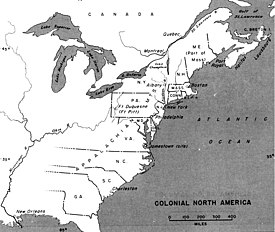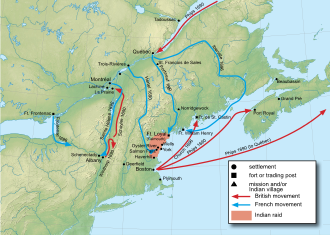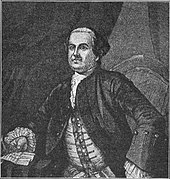King William's War
| King William's War | |||||||
|---|---|---|---|---|---|---|---|
| Part of the Nine Years' War | |||||||
 Count Frontenac, governor of New France, refused English demands to surrender prior to the Battle of Quebec. | |||||||
| |||||||
| Belligerents | |||||||
|
Wabanaki Confederacy Algonquin Kahnawake |
Mohicans | ||||||
| Commanders and leaders | |||||||
| Wars of Restoration England |
|---|
 |
King William's War (also known as the Second Indian War,
For King William's War, neither England nor France thought of weakening their position in Europe to support the war effort in North America.[6] New France and the Wabanaki Confederacy were able to thwart New England expansion into Acadia, whose border New France defined as the Kennebec River in southern Maine.[7]: 27 [8][9] According to the terms of the 1697 Peace of Ryswick that ended the Nine Years' War, the boundaries and outposts of New France, New England, and New York remained substantially unchanged.
The war was largely caused by the fact that the treaties and agreements that were reached at the end of King Philip's War (1675–1678) were not adhered to.[10] In addition, the English were alarmed that the Indians were receiving French or maybe Dutch aid. The Indians preyed on the English and their fears, by making it look as though they were with the French. The French were fooled as well, as they thought the Indians were working with the English. These occurrences, in addition to the fact that the English perceived the Indians as their subjects, despite the Indians' unwillingness to submit, eventually led to two conflicts, one of which was King William's War.[10]
North America at the end of the 17th century

The English settlers were more than 154,000 at the beginning of the war, outnumbering the French 12 to 1.[11] However, they were divided in multiple colonies along the Atlantic coast, which were unable to cooperate efficiently, and they were engulfed in the Glorious Revolution, creating tension among the colonists.[12] In addition, the English lacked military leadership and had a difficult relationship with their native Iroquois allies.[12][13]
Causes of the war
England's Catholic
In North America, there was significant tension between New France and the northern English colonies, which had in 1686 been united in the
There were similar tensions on the border between New England and Acadia, whose boundary New France defined as the Kennebec River in southern Maine.[7]: 27 English settlers from Massachusetts (whose charter included the Maine area) had expanded their settlements into Acadia. To secure New France's claim to present-day Maine, New France established Catholic missions among the three largest Indigenous villages in the region: one on the Kennebec River (Norridgewock); one further north on the Penobscot River (Penobscot) and one on the Saint John River (Medoctec).[16][17] For their part, in response to King Philip's War, the five Indigenous tribes in the region of Acadia created the Wabanaki Confederacy to form a political and military alliance with New France to stop the New England expansion.[18]
Course of war

New England, Acadia and Newfoundland Theatre
The New England, Acadia and Newfoundland Theatre of the war is also known as Castin's War[4] and Father Jean Baudoin's War.[3]
In April 1688, Governor Andros plundered Castine's home and village on Penobscot Bay (Castine, Maine).[7]: 607 Later in August, the English raided the French village of Chedabouctou. In response, Castin and the Wabanaki Confederacy engaged in the Northeast Coast Campaign of 1688 along the New England/Acadia border. They began August 13, 1688, at New Dartmouth (Newcastle), killing a few settlers. A few days later they killed two people at Yarmouth in the first battle. At Kennebunk, in the autumn of 1688, members of the Confederacy killed two families.
The following spring, in June 1689, several hundred Abenaki and Pennacook Indians under the command of Kancamagus and Mesandowit raided Dover, New Hampshire, killing more than 20 and taking 29 captives, who were sold into captivity in New France. In June, they killed four men at Saco. In response to these raids, a company of 24 men was raised to search for the bodies and pursue the natives. They were forced to return after they lost a quarter of their men in conflicts with the natives.[19]

In August 1689,
New England retaliated for these raids by sending Major
Battle of Port Royal (1690)

The New Englanders, led by Sir William Phips, retaliated by attacking Port Royal, the capital of Acadia. The Battle of Port Royal began on May 9, 1690.[23]: 82 Phips arrived with 736 New England men in seven English ships. Governor de Meneval fought for two days and then capitulated. The garrison was imprisoned in the church, and Governor de Meneval was confined to his house. The New Englanders levelled what was begun of the new fort.[24]: 38 The residents of Port Royal were imprisoned in the church and administered an oath of allegiance to the King.[24]: 39
Phips left, but warships from New York City arrived in June, which resulted in more destruction.[23]: 82 The seamen burned and looted the settlement, including the parish church.[24]: 40 The New Englanders left again, and Villebon, the governor of Acadia, moved the capital to safer territory inland at Fort Nashwaak (present-day Fredericton, New Brunswick). Fort Nashwaak remained the capital until after the war, when Port Royal was restored as the capital in 1699.[24]: 45
In Church's second expedition to Acadia, he arrived with 300 men at Casco Bay on 11 September 1690. His mission was to relieve the English Fort Pejpescot (present-day Brunswick, Maine), which had been taken by the Wabanaki Confederacy.[22]: 179–180 He went up the Androscoggin River to Fort Pejepscot.[21]: 66 From there he went 40 miles (64 km) upriver to Livermore Falls and attacked a native village. Church's men shot three or four native men when they were retreating. Church discovered five English captives in the wigwams. Church butchered six or seven natives and took nine prisoners.[21]: 67 A few days later, in retaliation, the members of the Wabanaki Confederacy attacked Church at Cape Elizabeth on Purpooduc Point, killing seven of his men and wounding 24 others.[21]: 69 On September 26, Church returned to Portsmouth, New Hampshire.
During King William's War, when the town of Wells contained about 80 houses and log cabins strung along the Post Road, it was attacked on June 9, 1691, by about 200 Native Americans commanded by the sachem Moxus. But Captain James Converse and his militia successfully defended Lieutenant Joseph Storer's garrison, which was surrounded by a gated palisade. Another sachem, Madockawando, threatened to return the next year "and have the dog Converse out of his den".[25]
As the natives withdrew, they went to York off Cape Neddick and boarded a vessel, killing most of the crew. They also burned a hamlet.[19]
In early 1692, an estimated 150 Abenakis commanded by officers of New France returned to York, killing about 100 of the English settlers and burning down buildings in what would become known as the
Church's third expedition to Acadia during the war was in 1692 when he raided Penobscot (present-day Indian Island, Maine) with 450 men.[22]: 212 Church and his men then went on to raid Taconock (Winslow, Maine).[22]: 214
In 1693, New England frigates attacked Port Royal again, burning almost a dozen houses and three barns full of grain.[24]: 43
On July 18, 1694, French soldier
Siege of Pemaquid (1696)
In 1696, New France and the tribes of the
In retaliation, Church went on his fourth expedition to Acadia and carried out a retaliatory raid against Acadian communities on the Isthmus of Chignecto and Fort Nashwack (present-day Fredericton, New Brunswick), which was then the capital of Acadia.[22]: 215 He led his troops personally in killing inhabitants of Chignecto, looting their household goods, burning their houses and slaughtering the livestock.
Quebec and New York Theatre
Also in August 1689, 1,500 Iroquois, seeking revenge for Governor General Denonville's actions, attacked the French settlement at Lachine. Count Frontenac, who replaced Denonville as governor general, later attacked the Iroquois village of Onondaga. New France and its Indian allies then attacked English frontier settlements in early 1690, most notably at Schenectady in New York.

This was followed by two expeditions. One, on land under Connecticut provincial militia general Fitz-John Winthrop, targeted Montreal; the other, led by Sir William Phips, targeted Quebec. Winthrop's expedition failed due to disease and supply issues, and Phips was defeated in the Battle of Quebec. The Quebec and Port Royal expeditions were the only major New England offensives of King William's War; for the remainder of the war the English colonists were primarily engaged in defensive operations, skirmishes and retaliatory raids.
The Iroquois Five Nations suffered from the weakness of their English allies.[26]: 290 In 1693 and 1696, the French and their Indian allies ravaged Iroquois towns and destroyed crops while New York colonists remained passive. After the English and French made peace in 1697, the Iroquois, now abandoned by the English colonists, remained at war with New France until 1701,[26]: 291 when a peace was agreed at Montreal between New France and a large number of Iroquois and other tribes.
Hudson Bay Theatre

The war also served as a backdrop for an ongoing economic war between French and English interests in Arctic North America. The Hudson's Bay Company had established trading outposts on James Bay and the southern reaches of Hudson Bay by the early 1680s. In a series of raids, beginning with the so-called Hudson Bay expedition, organized by Governor Denonville and continuing through the time of the Nine Years' War (1688–1697), most of these outposts, including Moose Factory, York Factory and Fort Albany, were taken by French raiders, primarily led by Pierre Le Moyne d'Iberville.
But the French forces were small, and their hold on the captured posts quite weak—York Factory was recaptured by the English in 1695. In 1697, in the Battle of Hudson's Bay, one of the war's major naval battles, d'Iberville, with a single ship, defeated three English ships and went on to again capture York Factory.
Aftermath
The
The Ryswick treaty was unsatisfactory to representatives of the Hudson's Bay Company. Since most of its trading posts in Hudson Bay had been lost to the French before the war began, the rule of status quo ante bellum meant that they remained under French control. The company recovered its territories at the negotiating table when the
Scholars debate whether the war was a contributing factor to the Salem witch trials. King William's War as well as King Philip's War (1675–78) led to the displacement of many refugees in Essex County. The refugees carried with them fears of the Indians, which is debated to have led to fears of witchcraft, especially since the devil was arguably closely associated with Indians and magic. Of course, Cotton Mather also wrote that it was going to lead to an age of sorrow and is arguably a proponent in leading Salem into the witchcraft crisis of 1692. Scholars debate this theory and one scholar, Jenny Hale Pulsipher, maintains that King William's War was more of a cause.[10] Other scholars that have written on the theory of the wars being a leading cause of the Salem Witchcraft Trials include Mary Beth Norton, James Kences, and Emerson Baker.
See also
- Colonial American military history
- Military history of Canada
- Military history of England
- Military history of France
Notes
Citations
- ^ a b Baudry, René (1979) [1966]. "Thury, Louis-Pierre". In Brown, George Williams (ed.). Dictionary of Canadian Biography. Vol. I (1000–1700) (online ed.). University of Toronto Press.
- ISBN 978-0-8122-1910-4– via Google books.
- ^ ISBN 978-0-88901-144-1– via Google books.
- ^ a b Sylvester, Herbert Milton (1910). Indian Wars of New England: The Land of the Abenake. The French Occupation. King Philip's War. St. Castin's War. Vol. I. Boston: W.B. Clarke Company. p. 54.
- ISBN 978-2-89448-186-8.
- ISBN 978-0-521-07524-4.
- ^ a b c Williamson, William D. (1832). The History of the State of Maine: From Its First Discovery, A. D. 1602, to the Separation, A. D. 1820, Inclusive. Vol. II. Glazier, Masters & Smith.
- ISBN 978-0-7735-2699-0.
- ISBN 978-0-86492-426-1.
- ^ S2CID 57560166.
- ISBN 978-0-7425-0019-8– via Google books.
- ^ ISBN 978-1-59884-530-3– via Google books.
- ISBN 978-0-7735-2219-0– via Google books.
- ^ ISBN 978-1-4728-0317-7– via Google books.
- ^ ISBN 978-0-8032-5932-4– via Gooble books.
- ^ Meductic Indian Village / Fort Meductic National Historic Site of Canada . Canadian Register of Historic Places. Retrieved December 20, 2011.
- ISBN 978-0-8061-3876-3– via Google books.
- ^ Prins, Harald E.L. (March 1999). Storm Clouds over Wabanakiak: Confederacy Diplomacy until Dummer's Treaty (1727). The Atlantic Policy Congress of First Nations Chiefs. Amherst, NS: Wabanaki. Archived from the original on 2011-07-19. Retrieved 2013-09-16.
- ^ ISBN 978-0-83280037-5– via Google books.
- ^ ISBN 978-1-55849-382-7.
- ^ a b c d Drake, Samuel Adams (1897). The Border Wars of New England: Commonly Called King William's and Queen Anne's Wars. New York: Charles Scribner's Sons.
- ^ ISBN 978-0-65911482-2– via Google books.
- ^ JSTOR j.ctt15jjfrm.
- ^ ISBN 978-1-55109-740-4.
- ISBN 978-1-58979-132-9– via Google books.
- ^ ISBN 978-0-14-200210-0.
- ISBN 978-0-15-503857-8.
- ^ Exercises of the Eliot Historical Society on Monday the fifth of July, 1897: In commemoration of Major Charles Frost on the two hundredth anniversary of his massacre by the Indians, Sunday, July fourth, 1697. Eliot, ME: The Society. 1897. p. 16 – via The Internet Archive.
References
- Baker, Emerson W.; JSTOR 3491676.
- Weidensaul, Scott (2012). "'Our Enimies are Exceedeingly Cruell'". The First Frontier: The Forgotten History of Struggle, Savagery, and Endurance in Early America. Houghton Mifflin Harcourt. pp. 182–221. ISBN 978-0-15-101515-3.
External links
 Texts on Wikisource:
Texts on Wikisource:
- "New International Encyclopedia. 1905.
- "King William's War". Collier's New Encyclopedia. 1921.
- "
- King William's War (1689–1697) at usahistory.info
